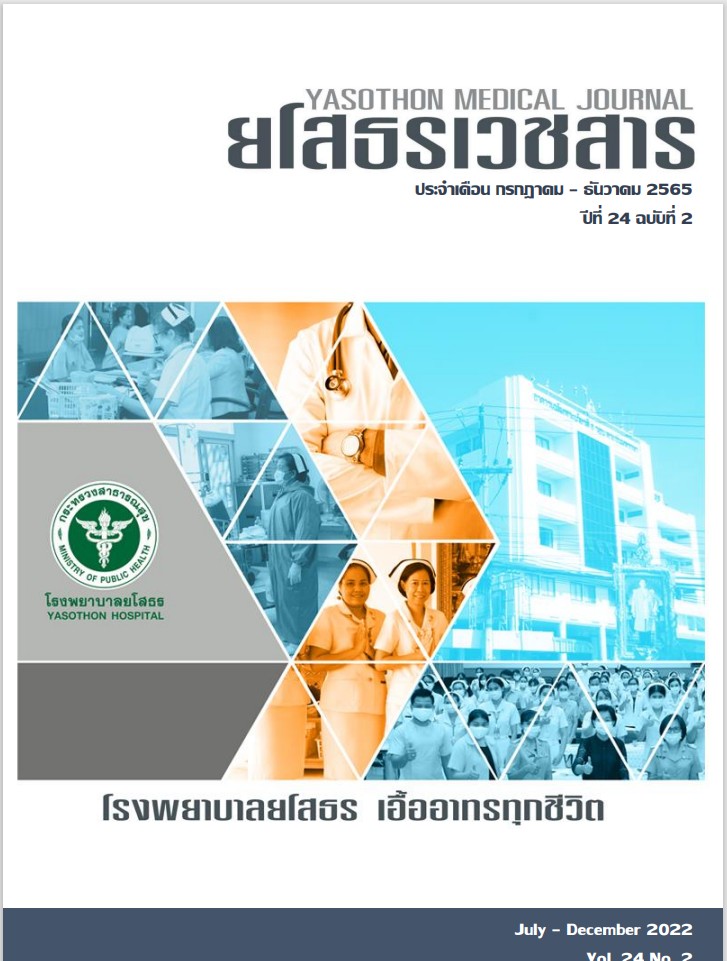สถานการณ์และปัจจัยที่สัมพันธ์กับการติดเชื้อแบคทีเรียดื้อยาต้านจุลชีพ ในแผนกกุมารเวชกรรม โรงพยาบาลยโสธร
บทคัดย่อ
ความเป็นมา: ปัญหาเชื้อดื้อต่อยาต้านจุลชีพเป็นปัญหาทางสาธารณสุขที่เกิดขึ้นทั่วโลก สถานการณ์การติดเชื้อดื้อยาทั้งใน
ประเทศและต่างประเทศมีแนวโน้มเพิ่มขึ้นและส่งผลกระทบเพิ่มความรุนแรงของโรค เพิ่มระยะเวลาในการนอนโรงพยาบาล
และเพิ่มอัตราการเสียชีวิตขึ้น
วัตถุประสงค์: เพื่อศึกษาสถานการณ์และปัจจัยที่สัมพันธ์กับการติดเชื้อแบคทีเรียดื้อยาต้านจุลชีพในแผนกกุมารเวชกรรม
โรงพยาบาลยโสธร
รูปแบบการวิจัย: ศึกษาแบบย้อนหลังจากเวชระเบียนผู้ป่วยเด็กอายุ 1 เดือนถึง 15 ปีที่มีผลการเพาะเชื้อจากกระแสเลือด
ปัสสาวะ อุจจาระ เสมหะและน้ำไขสันหลัง พบเชื้อแบคทีเรียตั้งแต่วันที่ 1 มกราคม 2563 ถึงวันที่ 31 ธันวาคม 2564 และ
วิเคราะห์ปัจจัยที่สัมพันธ์กับการติดเชื้อดื้อยา
ผลการศึกษา: ผู้ป่วยทั้งหมด 132 คน ส่วนใหญ่เป็นเพศชายร้อยละ 61.4 มีประวัติคลอดก่อนกำหนดร้อยละ 31.8 อัตราการ
เสียชีวิตร้อยละ 3 อัตราการเกิดเชื้อดื้อยา Acinetobacter spp. (68%), Klebsiella pneumonia (63.2%), Pseudomonas
aeruginosa (20%), Escherichia coli (93.3%), Salmonella spp. (16.7%), Staphylococcus aureus (16.7%),
Streptococcus pneumonia (100%) อัตราการติดเชื้อดื้อยาปีพ.ศ. 2563 (48.3%) ปีพ.ศ. 2564 (44.6%) และการติดเชื้อ
ในโรงพยาบาลปีพ.ศ. 2563 (39.7%) ปีพ.ศ. 2564 (41.9%) ปัจจัยที่มีความสัมพันธ์กับการติดเชื้อแบคทีเรียดื้อยาต้านจุลชีพ
ได้แก่ อายุ (p=0.008), ประวัติคลอดก่อนกำหนด (p<0.001), การมีภาวะแทรกซ้อน (p=0.003), การใส่สายสวนหลอดเลือด
(p=0.001), การให้สารอาหารทางหลอดเลือดดำ (p=0.022), การใช้เครื่องช่วยหายใจ (p=0.001), ชนิดยาต้านจุลชีพที่ให้
ครอบคลุมเชื้อ (p<0.001), การให้เลือดและสารประกอบของเลือด (p=0.005), จำนวนวันนอนโรงพยาบาล (p=0.022) และ
ผลการรักษา (p=0.004)
สรุป: การพบปัจจัยที่สัมพันธ์กับการติดเชื้อแบคทีเรียดื้อยาต้านจุลชีพนำไปสู่แนวทางการพัฒนากระบวนการดูแลผู้ป่วยที่เสี่ยง
ต่อการติดเชื้อดื้อยา และแม้ว่าแผนกกุมารเวชกรรม โรงพยาบาลยโสธร จะสามารถควบคุมสถานการณ์การติดเชื้อแบคทีเรีย
ดื้อต่อยาต้านจุลชีพให้ลดลงตามแนวนโยบายของกระทรวงสาธารณสุขประเทศไทย แต่การติดเชื้อดังกล่าวกลับมีสาเหตุมาจาก
การติดเชื้อในโรงพยาบาลเพิ่มมากขึ้น จึงควรมีแนวทางในการเฝ้าระวังการและควบคุมการติดเชื้อในโรงพยาบาล
เอกสารอ้างอิง
Interagency Coordination Group on Antimicrobial Resistance. No time to wait: Securing the future
from drug resistance infections. Report to secretary general United Nations [Internet]. 2019 [cited
Jun 23]. Available from: https://www.who.int/publications/i/item/no-time-to-wait-securingthe-future-from-drug-resistant-infections
World Health Organization. Global priority list of antibiotic-resistant bacteria to guide research,
discovery, and development of new antibiotics [Internet]. 2017 [cited 2022 Jun 23]. Available
Romandini A, Pani A, Schenardi PA, Pattarino GAC, De Giacomo C, Scaglione F. Antibiotic
Resistance in Pediatric Infections: Global Emerging Threats, Predicting the Near Future. Antibiotics
(Basel) 2021; 10(4): 393. doi:10.3390/antibiotics10040393. PubMed PMID: 33917430.
Sirijatuphat R, Sripanidkulchai K, Boonyasiri A, Rattanaumpawan P, Supapueng O, Kiratisin P, et al.
Implementation of global antimicrobial resistance surveillance system (GLASS) in patients with
bacteremia. PLoS ONE 2018; 13(1): e0190132.
คณะกรรมการประสานและบูรณาการงานดื้อยาต้านจุลชีพ สถาบันวิจัยระบบสาธารณสุข. แผนยุทธศาสตร์การ
จัดการดื้อยาต้านจุลชีพประเทศไทย พ.ศ. 2560-2564. กรุงเทพฯ: สถาบันวิจัยระบบสาธารณสุข; 2560.
ศูนย์เฝ้าระวังเชื้อดื้อยาแห่งประเทศไทย (NARST). สถานการณ์เชื้อดื้อยาต้านจุลชีพ 2000-2018 [Internet]. 2018
[cited 2019 Apr 1]. Available from: http://narst.dmsc.moph.go.th/data/AMR%202000-2018-12M.pdf.
Chotiprasitsakul D, Srichatrapimuk S, Kirdlarp S, Pyden AD, Santanirand, P. Epidemiology of
carbapenem-resistant Enterobacteriaceae: a 5-year experience at a tertiary care hospital. Infect
Drug Resist 2019; 12: 461-8. doi: 10.2147/IDR.S192540. PubMed PMID: 30863128.
ยุวดี แดงเพ็ง, คอปือเสาะ เจริญกุล. ความชุกของการติดเชื้อแบคทีเรียดื้อยาปฏิชีวนะกลุ่ม Carbapenem ในผู้ป่วยที่
เข้ารับการรักษาในโรงพยาบาลระดับตติยภูมิ จังหวัดชายแดนภาคใต้ของประเทศไทย. วารสารวิทยาศาสตร์สุขภาพ
มหาวิทยาลัยทักษิณ 2562; 1(2): 20-5.
วิษณุ ธรรมลิขิตกุล. คู่มือการควบคุมและป้องกันแบคทีเรียดื้อยาต้านจุลชีพในโรงพยาบาล. โครงการควบคุมและ
ป้องกันการดื้อยาต้านจุลชีพในประเทศไทย; 2558.
สุกัญญา บัวชุม, ไพโรจน์ โจวตระกูล, สุชาดา วงพระจันทร์. ปัจจัยที่มีความสัมพันธ์กับการติดเชื้อแบคทีเรียกลุ่ม
Enterobacteriaceae ที่ดื้อต่อยา Carbapenem : CRE ในผู้ป่วยที่เข้ารับการรักษาในผู้ป่วยใน โรงพยาบาลพิจิตร.
วารสารวิจัยและวิชาการสาธารณสุขจังหวัดพิจิตร 2563; 1(1): 1-9.
Chen Q, Li D, Beiersmann C, Neuhann F, Moazen B, Lu G, et al. Risk factors for antibiotic resistance
development in healthcare settings in China: a systematic review. Epidemiology and Infection
; 149: e141. doi: 10.1017/S0950268821001254. PubMed PMID: 34078502.
Guzman-Cottrill JA, Vaz LE. The systemic inflammatory response syndrome (SIRS), sepsis, and
septic shock. In: Long SS, Prober CG, Fischer M, eds. Principles and Practice of Pediatric Infectious
Diseases. 5
thed. Philadelphia, PA: Elsevier Saunders; 2018: 609-33.
แผนกกุมารเวชกรรม โรงพยาบาลยโสธร. รายงานข้อมูลจากระบบการส่งตรวจทางห้องปฏิบัติการเพาะเชื้อในผู้ป่วยที่
อายุน้อยกว่า 15 ปี โรงพยาบาลยโสธร ปีพ.ศ. 2563–2564. ยโสธร; 2565.
วรรษมน จันทรเบญจกุล, สุวพร อนุกูลเรืองกิตติ์, ธันยวีร์ ภูธนกิจ, ชิษณุ พันธุ์เจริญ. Drug-Resistant Organisms in
Pediatrics: Diagnosis and Treatment. กรุงเทพฯ: แอคทีฟพริ้นท์; 2562.
Pedro Tda C, Morcillo AM, Baracat EC. Etiology and prognostic factors of sepsis among children
and adolescents admitted to the intensive care unit. Rev Bras Ter Intensiva 2015; 27(3): 240-6. doi:
5935/0103-507X.20150044. PubMed PMID: 26465245.
Araya S, Galeano F, Amarilla S, González N, Apodaca S, Lovera D, et al. Prognostic factors of
severity of invasive community-acquired Staphylococcus aureus infections in children. Arch Argent
Pediatr 2019; 117(6): 381-7. doi: 10.5546/aap.2019.eng.381. PubMed PMID: 31758880.
Zhang Y, Cao B, Cao W, Miao H, Wu L. Clinical characteristics and death risk factors of severe
sepsis in children. Comput Math Methods Med 2022; 2022: 4200605. doi: 10.1155/222/4200605.
PubMed PMID: 35111234.
Maia dos Santos MLB, Taminato M, Delgado AF, Fernandes GJ, de Oliveira Achili Ferreira JC,
Carvalho WB. Prognostic Factors of Severely III Children with Klebsiella pneumoniae
Carbapenemase Blood Stream. Int J Nurs Health Care Res 2022; 5(2): 1-10. doi: 10.29011/2688-
101274.
Jin L, Zhao C, Li H, Wang R, Wang Q, Wang H. Clinical Profile, Prognostic Factors, and Outcome
Prediction in Hospitalized Patients with Bloodstream Infection: Results From a 10-Year Prospective
Multicenter Study. Frontiers in medicine 2021; 8: 1-8. doi: 10.3389/fmed.2021.629671.
Li SG, Hu FP, Zhou C, Xu XS, Fu CW, Liu XL, et al. Surveillance of bacterial resistance in children
and newborns across China from 2014 to 2017. Natl Med J China 2018; 98(40): 3279−87. doi:
3760/cma.j.issn.0376-2491.2018.40.013. PubMed PMID: 30392296.
Patil S, Chen H, Zhang X, Lian M, Ren PG, Wen F. Antimicrobial Resistance and Resistance
Determinant Insights into Multi-Drug Resistant Gram-Negative Bacteria Isolates from Paediatric
Patients in China. Infect Drug Resist 2019; 12: 3625-34. doi: 10.2147/IDR.S223736. PubMed PMID:
Villegas D, Echadia CA. Factors associated with mortality through sepsis syndrome in children 31
days to 14 years of age. Hospital Universitario del Valle, Cali. Colomb Med 2010; 41: 349-57. doi:
25100/cm.v41i4.727.
เผยแพร่แล้ว
รูปแบบการอ้างอิง
ฉบับ
ประเภทบทความ
สัญญาอนุญาต
ลิขสิทธิ์ (c) 2023 ยโสธรเวชสาร

อนุญาตภายใต้เงื่อนไข Creative Commons Attribution-NonCommercial-NoDerivatives 4.0 International License.
บทความที่ได้รับการตีพิมพ์เป็นลิขสิทธิ์ของยโสธรเวชสาร







